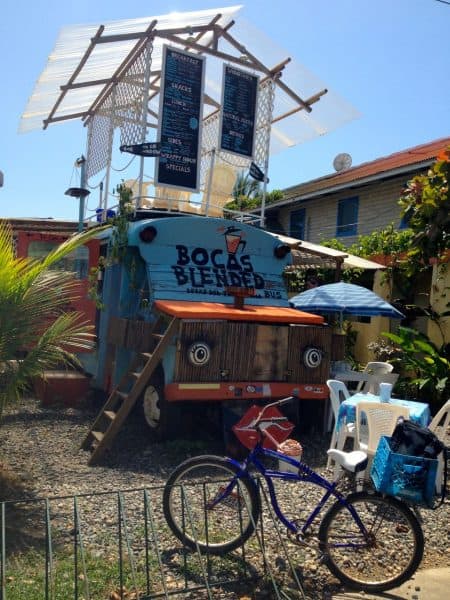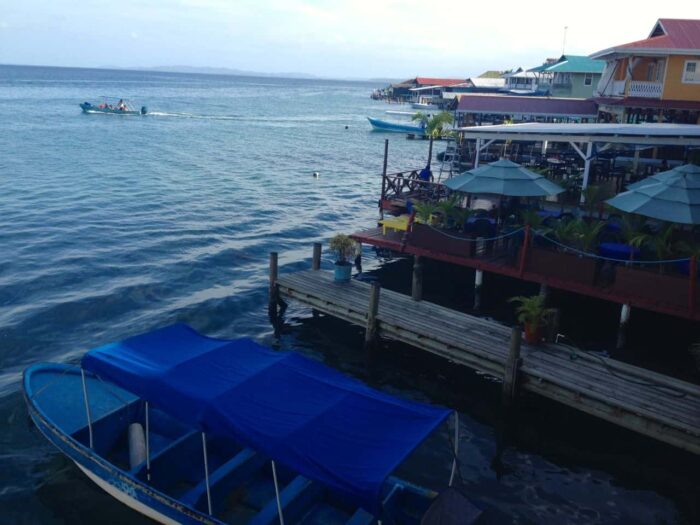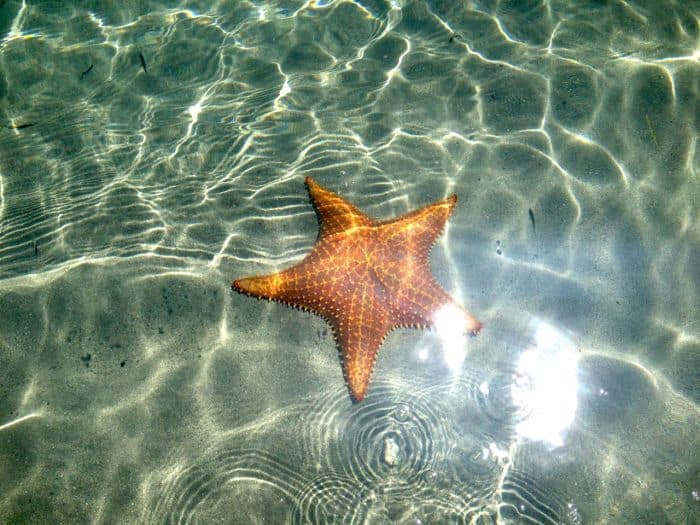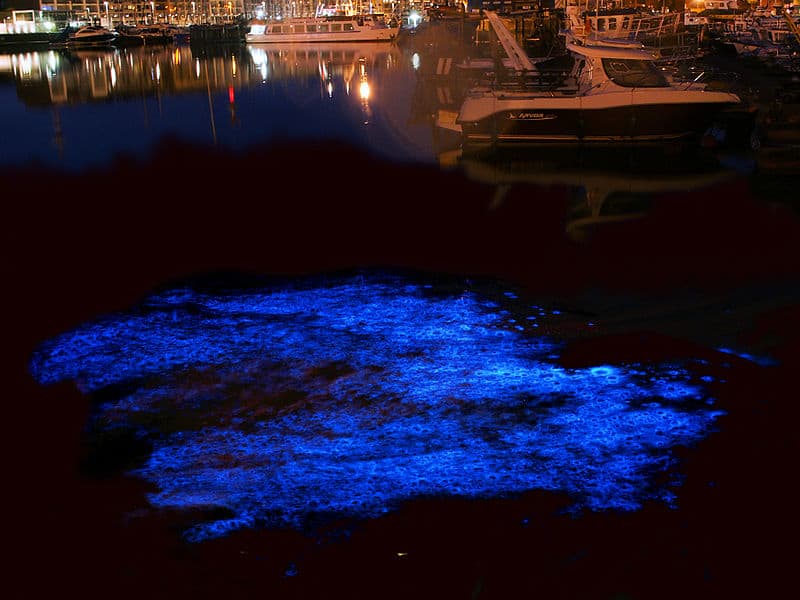At 9 p.m., the Bay of Almirante was a vast expanse of darkness dotted with distant lights. The rickety dock rocked beneath our feet and a lukewarm breeze came off that endless expanse of black water. As we stumbled aboard the motorboat, I realized that I had never really ventured into the ocean at night.
“Are you nervous?” I asked Erin.
“No,” she said. “Are you?”
“Yeah, actually.” I sat down in the crowded boat and fiddled with an antiquated orange life preserver. “The water looks a lot different when you can’t see it.”
The captain was a stout Panamanian I’ll call Jorge (all staff names have been changed), and when Jorge started the engine, he used its noise as an excuse to sing love songs at the top of his lungs. The boat angled forward, and once we were clear of the dock, we launched into the void. Spray blasted around the hull. The town of Bocas del Toro melted in the distance.
We didn’t know exactly where we were going or what we would see. We had only just met our guide, Jon, a skinny guy with long blond hair who looked scarcely adolescent. We weren’t even sure how long we’d be putting around the bay.
Only one thing was certain: Within the next couple hours, we would track down some bioluminescent phytoplankton, one of the most mystifying life forms in the sea. If all went well, we’d jump in the water and swim in it.
“I need to get out of town for a few days,” I told Erin, my colleague at The Tico Times and one of my favorite people to travel with. “Any interest in going to Bocas?”
“Yes!” she said. “I’ve been dying to go there!”
Most folks in Costa Rica know that Bocas del Toro is a kooky little province in the northeastern corner of Panama, a region famous for secluded islands, sprawling mangroves and armies of red tree frogs. Known among fans as simply “Bocas,” the main settlement is an old company town metamorphosed into a tourist mecca. The islands were once vassals of the United Fruit Company. Today, the place is overrun with backpackers and retirees from other countries.

While plenty of millionaires vacation in Bocas, the place has a countercultural flavor: Gringo’s Mexican is a quirky little restaurant run by a chatty Californian expat. Bocas Blended is a cute eatery built into a retired bus. Erin and I booked a room at Mar e Iguana (“Sea and Iguana”), a hostel on the outskirts of town. When the taxista drove us there, he pulled up to the beach, pointed to the hostel’s entrance, and said, “Estamos aquí. Mar e Iguana.”
“Oh, my God,” I said as we (gently) closed the taxi’s doors. “I didn’t even get that.”
“Get what?”
“The name of this place.”
“What about it?”
“Say it fast and don’t pronounce the ‘g.’”
“What? Marijuana?” As she said this, Erin’s jaw dropped, and we burst into cackles.
As it happened, Mar e Iguana was a tame – not to mention beautiful – little hostel, and most of its denizens were young Germans on their Wanderjahr. Bocas del Toro has its share of parties and reckless behavior, but a critical mass of visitors comes for more than cheap Balboa beer and ubiquitous ganja. They want to also lie on isolated beaches, go snorkeling near dolphin pods and climb into caves full of bats. They want to rent bicycles and pedal down jungle roads, or hike the trails of Red Frog Beach and admire the exotic birds.
The punishing heat of Bocas made any plan seem pointless, so Erin and I alternated between hammocks, beaches, seafood restaurants and bars. Bocas can feel very far from real life, especially if you spend most of your time in Costa Rica: You have to cross the trestle bridge at Sixaola, take buses or a cab to the coast, then board a water taxi and thread your way between the islands.
Sometimes the water shuts off or the electricity cuts out. Wifi is patchy, and we never found an Internet café. These inconveniences are all part of Bocas del Toro’s freewheeling charm, and we found excuse after excuse not to do anything meaningful.

Then, during one of our long strolls through town, we found a handwritten sign: “BIOLUMINESCENT TOURS.” We had both seen this phenomenon before, but only in small doses. We talked with a drowsy-looking girl from California named Jaime, who described the tour.
“We meet up around 8 o’clock,” she said. “We take you out in a boat, and you get to see the algae. Then you get to jump in and swim around with masks. It’s really amazing.” Then she looked up at the opal afternoon sky and added, “Tonight is the new moon, which means it’s the best night of the month to see it.”
Jaime started the tour about a year ago, and she has continued its operation with her boyfriend Jon, who was born in Holland but raised in Panama. What was striking about the tour was its price tag: $25 U.S. Like so many activities in Central America, some parts of Bocas del Toro are best visited with guides – and many of these tours are cheap and easy to arrange.
“So I brought a GoPro with me,” I told Jaime. “Do you think it’ll work?”
“Honestly,” she said, “don’t bother. People take cameras all the time, and all they get is a black screen. There are ways to take pictures of bioluminescent algae, but only if you’re an expert. Like a National Geographic photographer probably could, and I’ve seen pictures online, but most of us can’t. So you’re welcome to bring it along, but I’m pretty sure you’re not going to get anything.”
We booked two seats on the boat, grabbed some pad thai, and headed to the hostel to grab our swimsuits. Within a few hours, the sun had set, night had fallen over the town, and we were ready to sail.
Jorge veered the boat sideways, and we started motoring into a tight circle. As water riffled along the hull, we could see thousands of faint specs light up in the liquid furrows.
“This is the bioluminescent phytoplankton,” said Jon triumphantly.
With the exception of fireflies and glowworms, bioluminescence is a rare sight in the terrestrial world. Mammals and reptiles generally have no need to glow in the dark, so when the lights go out, so do we. But underwater, bioluminescence is a common trait, and the more fathoms you descend, the more glowing creatures you’ll find. There are lots of reasons that deep-sea animals have evolved this way, from intimidating predators to lighting their way in the Mariana Trench.
Yet nothing is quite as startling as bioluminescent phytoplankton. Aroused by movement, this algae forms galactic patterns in the water.
“Scientists call them dinoflagellates,” shouted Jon over the roar of the engine.
“Now that’s a name!” someone shouted back, and everybody laughed.
There were about a dozen of us, and we were all under 35. As members of the digital generation, most of the passengers started frantically shooting the water with their cameras and phones, trying to capture images of the algae. Flashes burst blindingly in the dark, but when the snapshots registered on their screens, they showed only blackness or abstract light patterns.
“Seriously, guys,” said Jon in his surfer-dude cadence. “You’re not going to get a picture of them, especially with flash. You’re just making it harder for other people to see.”
Flash or no flash, the plankton was hard to see. At first the algae was subtle, mere pointillist gray spots, and Erin and I kept murmuring our disappointment.
“I really don’t see much,” she said. “It’s just like a couple of dots.”
Then the boat drifted into the mangroves, and Jorge switched off the engine. He and Jon handed paddles and wood poles down the aisles of seats, and each of us dipped our implements in the water. With each swish of a paddle, algae bubbled around like heaps of diamonds. “Oh, wow!” we cooed, because there was nothing else to say. Words were as ineffectual as camera lenses.
“So are we swimming here?” someone called to Jon.
“Not here,” Jon said. “Back in the bay.”
“Why not here?”
“Look around,” Jon said, gesturing to the curtains of foliage that hung over the water. “It’s creepy.” Again, everyone laughed. “Also, this is where lots of fish come to feed, and they’re attracted to the bioluminescence. Then sharks come to eat the fish. The chances of a shark attacking you are point-zero-zero-zero-zero-one percent. But where we’re going, we’ll be a hundred percent safe.”
Anchored off an island the size of a baseball mound, we slipped off the gunwales into the unseen water. One by one, bodies vanished into the umbra, and then we heard heads popping back up, spitting water and crying, “Oh, it’s cold!”
But I adjusted quickly to the tropical water, delighting to taste salt on my lips. Jon advised us to stay on the surface, for fear we’d touch the bottom and impale our feet on a sea urchin. I felt buoyant and free, and I spent long minutes floating on my back, watching the starry cosmos rotate above.
“Mask?” someone called out.
“Here!” I called back.
I strapped on the rubber mask and dipped my face into the ripples. Just as Jaime predicted, glowing particles swarmed around my hands. The tiniest wiggle of my thumb caused microscopic sparks to swirl. Kicking my feet raised clouds of algae, and when I ran fingers through my chest hair, specs lit up.
“Erin!” I said, ripping off the mask and handing it off.
“This… is… awesome…” Erin intoned, once she’d come up for breath.
As we dog-paddled around the boat, unafraid of the obscure depths, lost in the wonder of the moment, it occurred to me how spoiled a visitor can become in Central America. Things that once seemed to exist only in magazines – sloths, cloud forests, waterfalls descending into jungle ravines – are everyday sights in Costa Rica and Panama. Surfing and scuba diving once seemed hopelessly exotic to me, but in recent months I’ve been able to try either on a whim.

Indeed, bioluminescent phytoplankton is fairly common, and not just in Panama: Backpackers later told me about blooms off the coast of Nicoya, which they claimed were visible from the beach.
But as we climbed awkwardly back into the boat, reluctant to leave our dark patch of illuminated life, I hoped never to let that novelty wear off. Part of what makes Central America so wondrous, especially for people who grew up elsewhere, is the richness of its species. Hardened urban Yankees come to Central America and wander around the national parks, slack-jawed, because every little leafcutter ant enthralls them.
The next day, the hostel’s water cut out. Already sweat-matted, we trekked through the sweltering heat, all the way back to Sixaola. As we scrambled aboard the bus for San José – only minutes before its departure – Erin smiled broadly and said, “Hey, I’m still covered in bioluminescent phytoplankton. How about you?”
“Why, yes I am,” I said.
That’s the thing about nature: It sticks with you.






